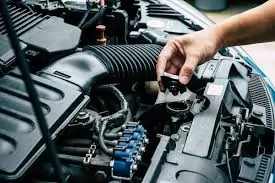Radiator Flush Guide for Ford, Toyota, Chevy & Honda: Coolant Safety & DIY
Radiator Flush Guide for Ford, Toyota, Chevy & Honda
A radiator flush is a simple yet **powerful service** that removes rust, scale, and dirt from your cooling system. Performing this maintenance helps your Ford, Toyota, Chevy, or Honda run cooler and last longer, preventing expensive overheating problems. Because of this, many experts recommend a flush every few years.
CRITICAL WARNING: Always use Distilled Water. Never use tap water for flushing or mixing coolant. Tap water contains minerals that create scale, causing clogs and damaging your engine over time.
Why Radiator Flush Matters
Coolant (Antifreeze) contains vital corrosion inhibitors that weaken and turn acidic over time. Therefore, it eventually stops protecting the engine as it should. When corrosion and mineral deposits build, they can block coolant flow. As a result, your engine may overheat, potentially leading to a costly head gasket failure. A flush restores clean flow and helps **extend engine life**.
To understand how your cooling system works and why the fluid is so important, see the Internal Combustion Engine Cooling Wikipedia page. —
Understanding Coolant Technology (IAT, OAT, HOAT)
Coolants are **not interchangeable**; mixing the wrong types can cause the coolant to turn into a gel or sludge, leading to immediate system failure. You must use the type specified in your owner’s manual:
- IAT (Inorganic Acid Technology): Usually green. Used in older vehicles. Requires more frequent changes.
- OAT (Organic Acid Technology): Often orange (like Dex-Cool for Chevy) or yellow/pink. Designed for extended life.
- HOAT (Hybrid Organic Acid Technology): A mix of IAT and OAT, commonly used by Ford and others.
—
Flush Intervals by Brand
- Ford: Typically every 30,000 miles or 2–3 years, though newer models with specific coolants (e.g., Motorcraft Gold or Orange) may last longer.
- Toyota: Models using Super Long-Life Coolant (SLLC) may go up to 100,000–150,000 miles, but always check the color and bottle.
- Chevy: Dex-Cool (OAT) can last up to 150,000 miles or 5 years, but flushing earlier is a safer preventative measure.
- Honda: Most models require service around 45,000–60,000 miles using Honda Type 2 Coolant.
—
How to Flush a Radiator: Step-by-Step
Step 1: Prepare & Cool Down
First, park your vehicle on **level ground** and ensure the engine is **completely cool**. Put on safety gloves and goggles, and set a drain pan under the car.
Step 2: Drain Old Coolant
Next, open the radiator drain valve (petcock) or remove the lower radiator hose. Collect all old coolant safely. Because coolant is **toxic**, always dispose of it properly at a recycling center.
Step 3: Flush & Rinse
Close the valve and fill the system with flush solution and **distilled water**. Run the engine with the heater on for 10–15 minutes. Drain again. Repeat this step using **only distilled water** until the fluid draining out is perfectly clear.
Step 4: Refill and Bleed Air (Crucial)
Now, refill the system with the correct coolant mix (50/50 coolant and **distilled water** or use pre-mixed coolant). To prevent air pockets (hot spots), run the engine with the radiator cap off and the heater on. As the engine warms, squeeze the large upper radiator hose and top up the coolant as trapped air bubbles escape. Replace the cap only after the level stabilizes. —
Cost of Radiator Flush
Most independent U.S. shops charge **$100–$200** for a standard flush and fill service. Dealerships and specialty shops may cost more. Performing a careful DIY flush can save you money, typically costing only the price of the coolant and a small fee for proper fluid disposal. For a detailed cost comparison, see the radiator flush tutorial. —
Extra Cooling Tips
- Check hoses for cracks and stiffness every season.
- Always check your system’s pressure and temperature after a flush.
- Test coolant strength (freeze/boil point) twice a year with an inexpensive hydrometer.
- Dispose of old coolant at a certified hazardous waste or recycling center.

